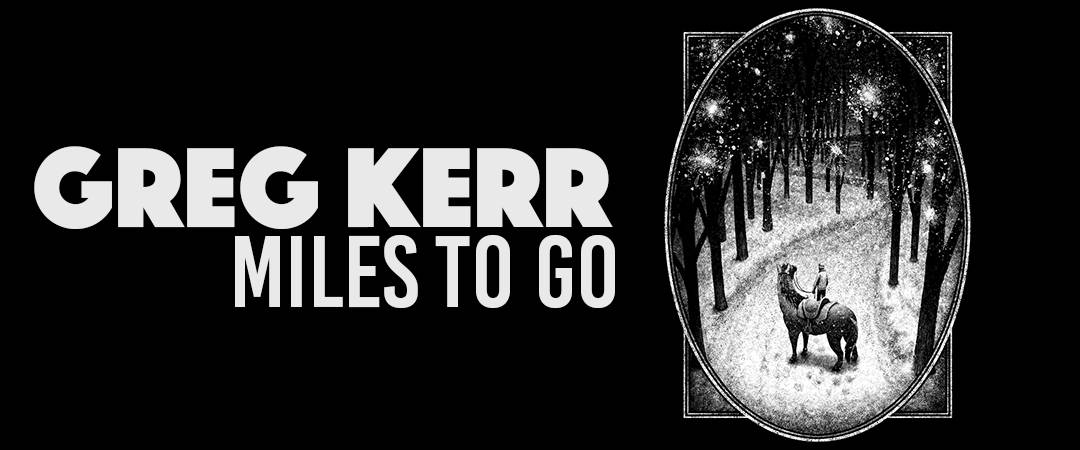
Robert Frost‘s 1922 poem ‘Stopping by Woods on a Snowy Evening‘ was famously read by newscaster Sid Davis to honor U.S. President John F. Kennedy on the day of Kennedy’s funeral. The poem ends with —
The woods are lovely, dark and deep,
But I have promises to keep,
And miles to go before I sleep,
And miles to go before I sleep.
For the eulogized Kennedy that last phrase, ‘and miles to go before I sleep,’ was spoken to honor the next step in his existence, the dead will keep moving — death is not the end. The line ‘...miles to go‘ is a humble reminder that there is always more distance to cover — whether it be physically, mentally, or spiritually. These words can act as a life’s ethos.
It is fitting that this phrase was chosen by artist / printmaker / entrepreneur Greg Kerr as the name of his clothing line. At the end of each creative endeavor, there is more to go. More art to make. More inspiration to gather. Kerr began Miles to Go to bring his love of art and the written word together — the illustrations that adorn his shirts are not literal representations of a novel’s narrative, but evocative of tone and mood. Each tee shirt or tote bag adheres to the appreciation readers have for their favorite books and writers.
For a reader to be immersed in Tolstoy‘s ‘War and Peace‘ is to find someone willing to pay attention to details — each word and moment builds into a greater whole. To bring ‘War and Peace‘ to his brand, Kerr’s route is through the art of illustrator Alan Campbell, whose work explores Tolstoy’s beehive metaphor and the aristocracy inherent in the novel. For fans of Aldous Huxley‘s brilliant ‘Brave New World,’ illustrator Kevin Tong‘s design speaks to the novel’s dystopian vision of a productive future. Through Miles to Go, Kerr explores each author and novel with a reader’s eye — he is not out to only sell tee shirts, but also the concepts and ideas of figures like Huxley and Tolstoy.
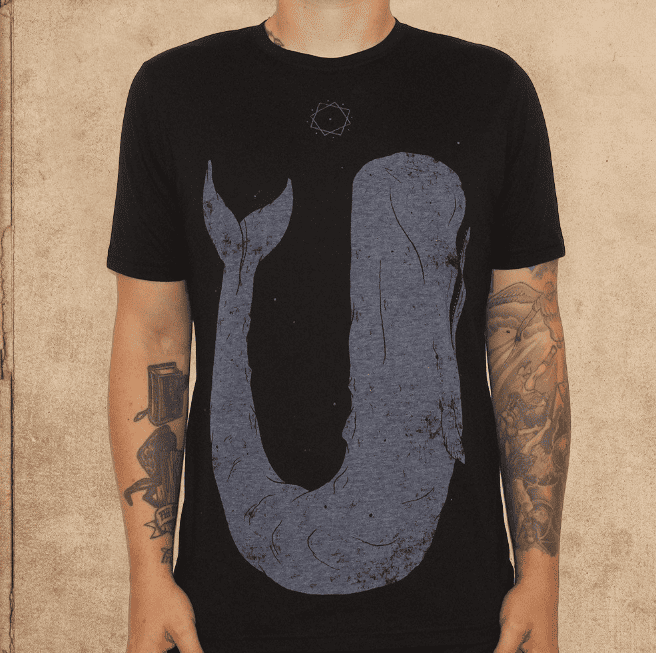
‘Moby Dick’ illustration by Keaton Henson
Outside the art itself, what I love about Miles To Go is that it treats literature in a manner that is reserved for bands or comic books. What came first — the desire to promote books and authors or the desire to have a storefront of unique art?
When I started Miles to Go back in ’07, I was just making shirts based off of things I dug like jazz, religious art, and of course books. As I kept moving forward and making new designs, I found that doing designs based off of literature kept me interested and even though it seemed like an idea people may not be into at the time in the market, I pushed forward and I’ve been making almost only literary inspired designs for the past 7 – 8 years.
As a heavy reader and lover of art, it was a great marriage for me to be able to hire artists I admired and to create something new. I’ve been fortunate enough to work with so many talented artists.
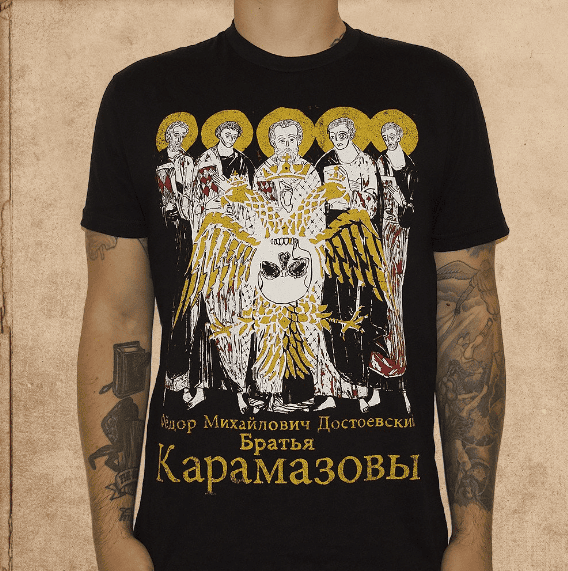
‘The Brothers Karamazov’ illustration by Alan Campbell
How are you finding the artists? Are you pitching books and authors to illustrators, or are they coming to you with ideas?
The majority of the time I see someone’s art and just want to work with them, so I reach out to see what their rates are and if they have interest in working with me. The ideas for designs always come first and then I try to pair an artist with it who I think will translate my idea best.
These days I do get a decent amount of artists emailing me too and usually, it’s because they like the brand or have made literary art independently and I’ve gone on to work with a lot of those artists. Alan Campbell is an example of that. He emailed me, I loved his work and picked up 3 designs from him and just slapped my Miles to Go vibe onto them. When I pitch artists, I do always ask them if there’s anything they would be interested in tackling too. Thankfully a lot of artists are really well-read and if there’s a book they love, I know the design will be great.
I first like to establish an artist’s rates to see if I can afford them because each artist has their own rate set and I know my budgets. I never ask people to change their rate, but I will sometimes see if there’s a deal to get two designs at once. If an artist is out of my budget, I will say thank you and that hopefully, I will be back when I can afford them. I also make to make sure someone has the time available and interest in working with me.
A lot of the artists I use have a lot going on and are at the level that they can choose their projects, so it’s important to me that they want to work together. I will both pitch some ideas and books I’m looking to do as well as potential authors I’m always down for. If an artist wants to do a Vonnegut that I haven’t done yet, I’m in. The hope is that we can either land on something we agree upon that they are interested in or they are open to the idea I have in my design brief, even if they aren’t familiar with the book.
I’m hands-on in the extent of giving ideas, possible compositional elements, and overall balance. If an artist pitches me with an idea for something they want to do that maybe a bit more esoteric but sounds interesting, I am ok saying, ‘for X design I’m looking for, your pricing fits, but if you’d like to also do that other design as a second piece because it’s less well known, my budget would be X for it,’ and let them decide. Good art sells (usually), but the lesser-known a book is, the lower the sales for it tend to be, and that directly impacts my budget.
For an example of my level of involvement, on the new ‘Lord of the Flies‘ design, I told the artist I wanted the kid as the main focal element with the spear and shell and to have the other kids as a background supporting element, my max size proportions for a print and number of colors. I was sent some rough sketches to establish the composition, approved one and we moved on to the final piece. Once I got the art, I felt that the main child needed to be a little larger, so I hacked and slashed some things in the art to make it work better for a shirt and made sure the artist was ok with my changes before I proceeded to get ready to print it. I changed some colors and picked the garment color I felt worked best for Miles to Go and did a limited variant edition on the color he preferred.
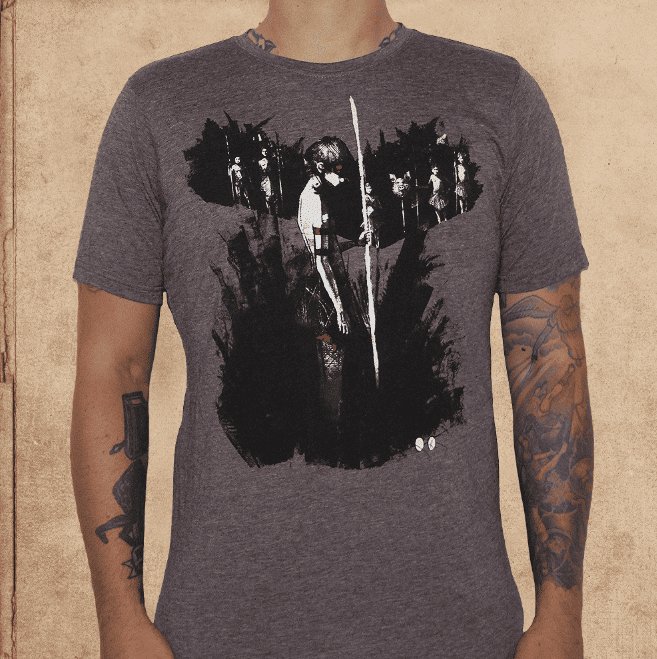
‘Lord Of The Flies’ illustration by Ryan Quackenbush
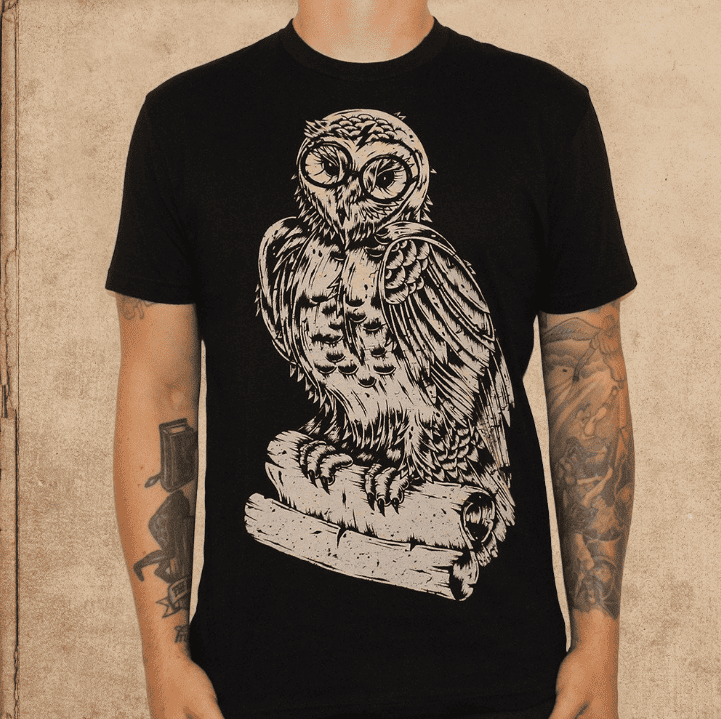
‘Harry Potter Owl’ illustration by John Hobbs
Are you working strictly with public domain works? Any desire to get into licensed properties?
I’m walking a very fine line and although I do do a good amount of public domain books, I also do books not in the public space. I have tried to reach out to some publishers and so far no one has gotten mad at me or even seemed to mind.
Even with a licensed property like Harry Potter, I have zero interest in actually using anything like a portrait of Daniel Radcliffe or printing the name on the design. I prefer to come up with original art imagined from the story. If I were doing parodies that damaged the properties instead of trying to promote them in a new light, I’m sure it would be a different story.
In previous interviews, you’ve mentioned having a booth at various conventions. How do the shirts go over? Have you been surprised by who your audience is?
I used to sell at a ton of events maybe 5 – 6 years ago and it helped get the word out to people who may not have found out about me. These days I only do Phoenix Comic Con because it’s down the street from me, but the response is crazy. It’s always fun to get to talk books with people and I never judge or can guess who is going to be the heavy reader and who just likes the art. The goal for me is to maybe interest someone in a book they haven’t read by creating cool art.
It’s crazy to me that there are 1,000 more miles to go shirts walking around Phoenix now from one event. It’s just too hard for me to do a ton of events these days because I have so many products and my time is thin. Taking a week away from wholesale for Comic-Con got me so far behind.
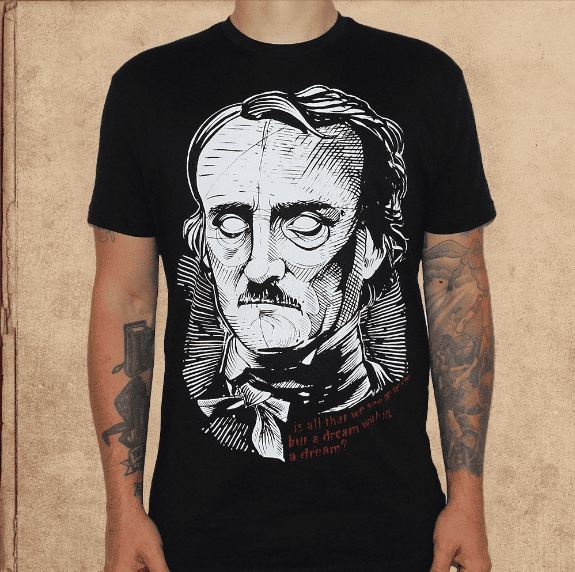
‘Edgar Allan Poe’ by Cutty Bage
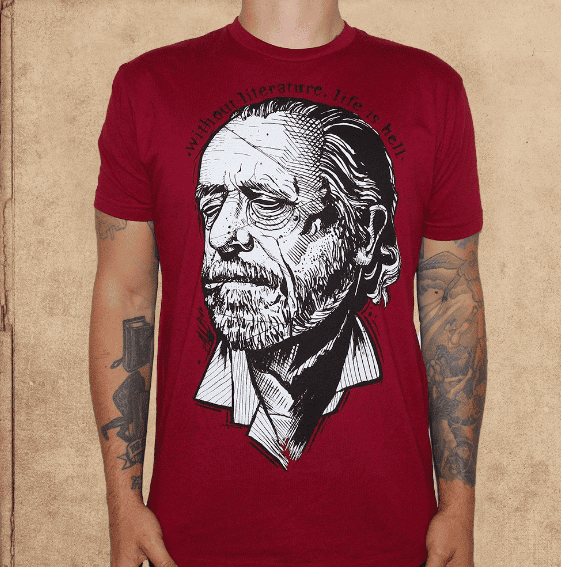
‘Charles Bukowski’ illustration by Cutty Bage
What makes someone like Charles Bukowski work as tee shirt illustration? Do some writers and novels lend themselves to the product line more than others?
I always have a running list of books or poems I’d love to do and for the most part, it all comes down to the right idea. It’s not always easy to encompass a novel in a single image that doesn’t beat you over the head with what it is. I love Bukowski and the artist who did that I had worked with before and she made it on her own for fun, so I asked to pick it up and asked her to do a Poe in the same style.
Authors like Bukowski who have a misanthropic thread to their work tend to connect with a lot of readers. People who prefer the comfort of a book over social engagement seem to dig the heavy stuff. Plus, Bukowski’s face is too interesting to not do.
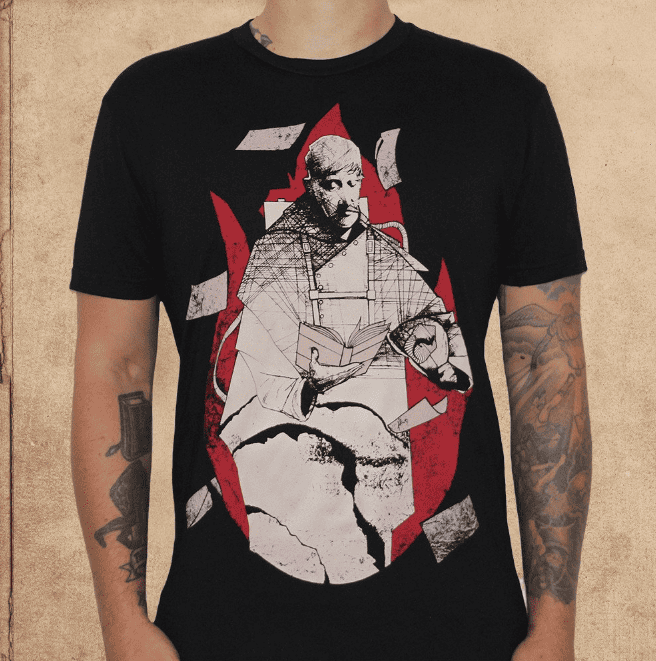
‘Fahrenheit 451’ by Ryan Quackenbush
There is a cohesive nature to what you choose to include in the shop. Bradbury to Poe isn’t too big of a jump for readers. Are there any books or authors you’d love to include but don’t feel could work? Any secret love of romance or YA novels?
I have done some YA novels like John Green‘s ‘Looking for Alaska‘ and ‘Perks of Being a Wallflower‘ but I did those because I loved the books. I don’t hate on any books, YA or not. I read ‘Hunger Games,’ but I didn’t feel the need to make a design for it. When I read ‘Looking for Alaska,’ he hadn’t gotten huge with ‘The Fault in Our Stars‘ yet and I just loved the book so much I had to make a design for it.
Every once in a while I like to toss in either newer novels or maybe lesser known books, but a book’s popularity has a direct impact on its sales and I hire artists, so deciding to make a new design has me $1k deep before it’s even sold. With Miles to Go being my way to support my family, I do need to consider those things. If I decide to do a design like that, I’ll try to balance it in a release with a heavy hitter I think will do well long term.
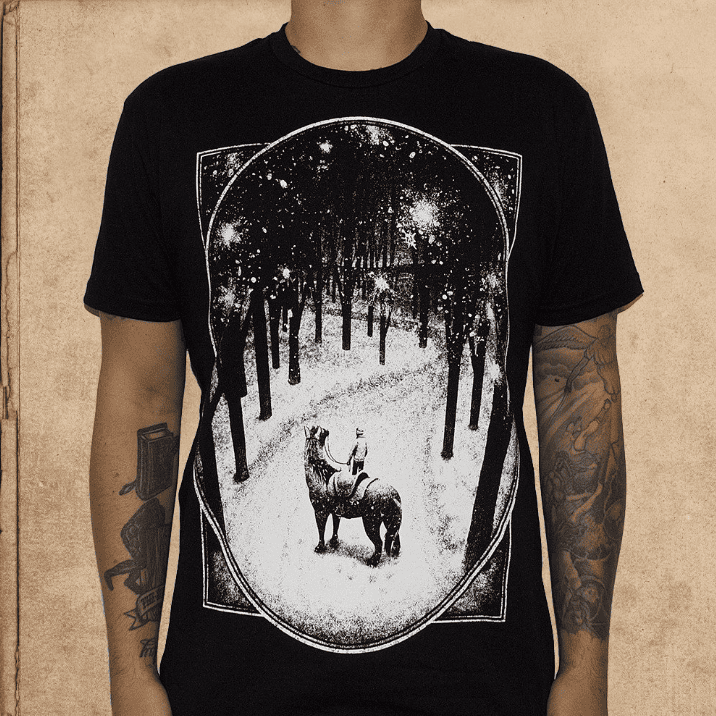
‘Stopping By The Woods’ illustration by Brian Luong
Have you had to turn down any illustrations? Is it worth the risk to print shirts with a design you aren’t 100% behind? I can see a situation of, “Well, people will buy anything with a skull on it,” so that skull design you’re not in love with gets made. How much do you consider what the audience will want, or has wanted, when it comes to choosing what to make?
I haven’t had to turn anything down yet. I only hire people whose work I know and can trust. If I see a portfolio that is all over the place, chances are that I won’t hire the artist. I will take a heavily stylistic interpretation over boring skulls any day.
I tend to send a pretty detailed proof and ask to approve a rough sketch before they do any real work on a design. It can be a 3 min napkin sketch, but the flow of the design and composition are really important to me. Not everything works well on a shirt and I have had to re-assemble things from time to time to make it look better on a tee.
People ask me to do books all of the time, but I don’t think they realize how much goes into making a design. It’s lead me to read some amazing books I hadn’t read though. I also tend to stay away from things with a well-known movie because people have a set image in their head of what it should be. I’d rather do ‘Survivor‘ by Palahniuk than do ‘Fight Club.’ How do you really make something new for that?
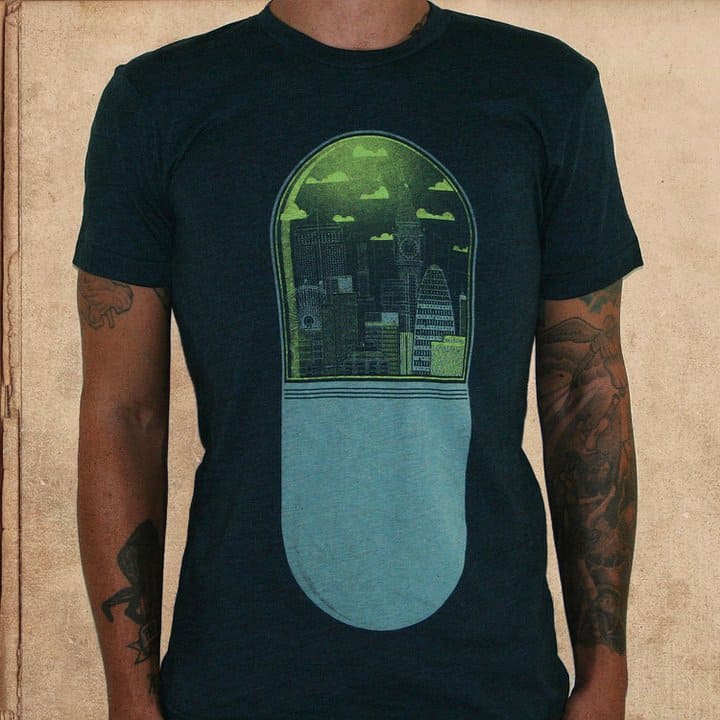
‘Brave New World’ illustration by Kevin Tong
Do you treat the illustrations as limited edition? Once a design sells out, are you reprinting those at some point? I just realized that an old Kevin Tong illustration for ‘Brave New World’ was actually done for Miles to Go, will something like that see another round of shirts or possibly a pin?
I do not treat the art as limited edition, ever. I may do a limited variant on another color that will never again print that way, like when I did Colin Frangicetto‘s ‘Clockwork Orange‘, we did a small run on orange shirts. ‘Brave New World‘ (may have been made in 2012) has come back in a few different versions over the years and I do love that art. Kevin‘s work is just mind numbing and I’m proud to have been able to print some of his work.
Shirts cycle and after ten years, there’s a lot not for sale right now that I’ve released in the past. If I feel like bringing it back, I do and see how it goes. Kevin’s ‘War of the Worlds‘ came back last year again, but as I get into fall and it sells out. I do bring things back sometimes as pins, but his work, for example, would be really tough to do at such a small size because of all of the details and because when I commissioned the work, that hadn’t been discussed, I wouldn’t make the pins without asking him first.
Certain designs that I commission, I buy full rights to and for artists that make a living off of selling prints, I usually just buy apparel rights and things like a tote or whatever products I may make and allow them to make and sell as many prints as they desire to make extra money. My customers don’t really come to me to buy posters, so if an artist can make money to their followers off of a print of the work I hired them to create, I’m all for it. I also don’t option art for a limited amount of time. If I’m commissioning someone to create something for my brand, it’s success or failure falls into my lap. There are shirts I’ve sold a thousand of from an artist and a different design that sold 40 and never reprinted again.

‘A Clockwork Orange’ illustration by Colin Frangicetto
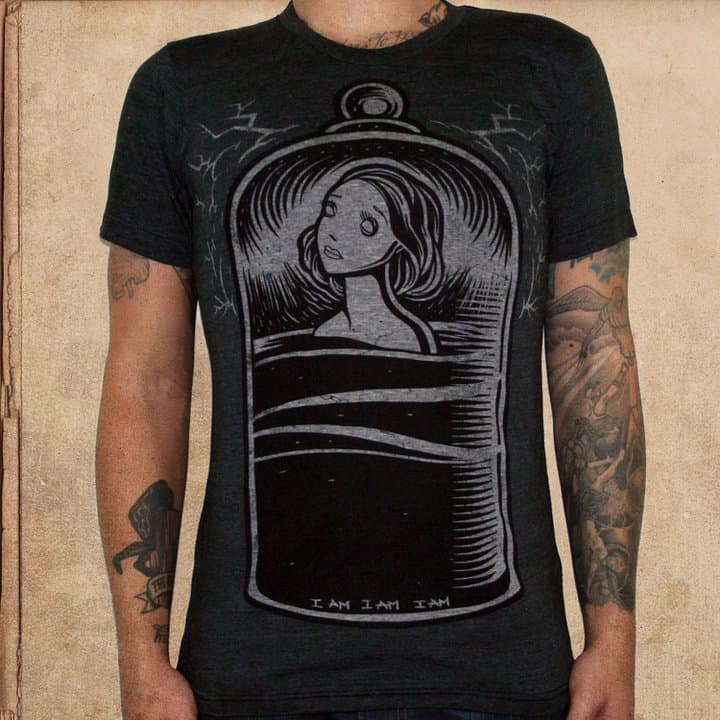
‘The Bell Jar’ by Dave Quiggle
How closely are you observing your peers? Do you concern yourself with how other clothing lines are doing, at least to gauge business practices?
I really don’t pay much mind to be honest. Miles to Go has always operated outside of whatever trend was happening, so the new cool thing isn’t going to have much impact on me. I’ve always just done miles to go how I wanted and try to keep a consistent vibe to the brand. Every once in a while I will check in on my main competitor, but mostly to see what they are offering. They only print old book covers and I get original art made to re-create a novel, so the vibe is way different. When I started, people told me I was crazy to not print my name on the shirts and to base them off of books. I’m in over 300 indie bookstores currently, so it’s gone ok.
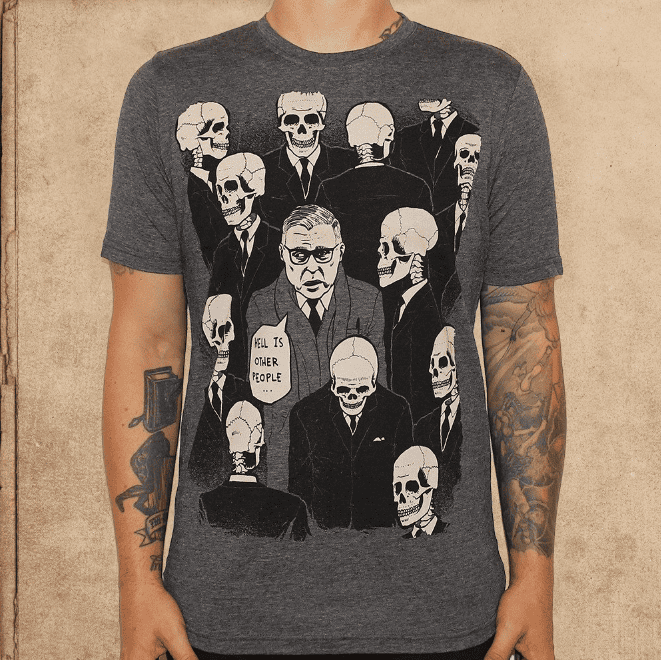
Jean-Paul Sartre
Yeah, that’s awesome to see. You’ve got Miles to Go products in shops across the country, which is no easy feat. What’s the next goal? Would having the shirts available at Target or Wal-Mart be a good thing, or do you want to keep it a small shop?
I have zero interest in selling to any major chain stores. I did a run with Urban a few years ago and the whole thing just wasn’t worth it. I like selling to indie bookstores and I can actually get my wholesale price I ask for and not $6.25 that Urban offers. I do sell to the two biggest distributors to bookstores and saw that some of my totes were in a Barnes and Noble, but they bought them from the distributor.
I have a sales number that I think is attainable in the next year or so that would keep me busy but not require a warehouse and tons of employees. It’s nice to actually become friendly with buyers at stores and deal with them directly.
The Miles to Go Belts site is currently down – is that part of your business done, or has it just become an offline entity?
I reached a point that I had to just get rid of the belts. It had a good 15-year run and I got to make merch for a ton of awesome companies from Domino’s Pizza to Johnny Cupcakes, Gorilla Biscuits to Fall Out Boy and it paid my bills for years but sometimes you gotta know when to send something off into the sunset. I had tons of people attempt to knock me off over the years, but the belts were such a pain to make and so specific that I had the room at a set temperature, and everything timed, so I think people just gave up.
I debated trying to sell it because it made good money for me and could have for someone else, but I didn’t feel like having to train someone to do it and was just bored. Oddly enough, I have transitioned into making enamel pins for people and that’s been great. My years of making merchandise for others have made me able to step into production for others with pingamestrong.com I think I just like making things and being able to help others make something interesting with their art is rewarding.
